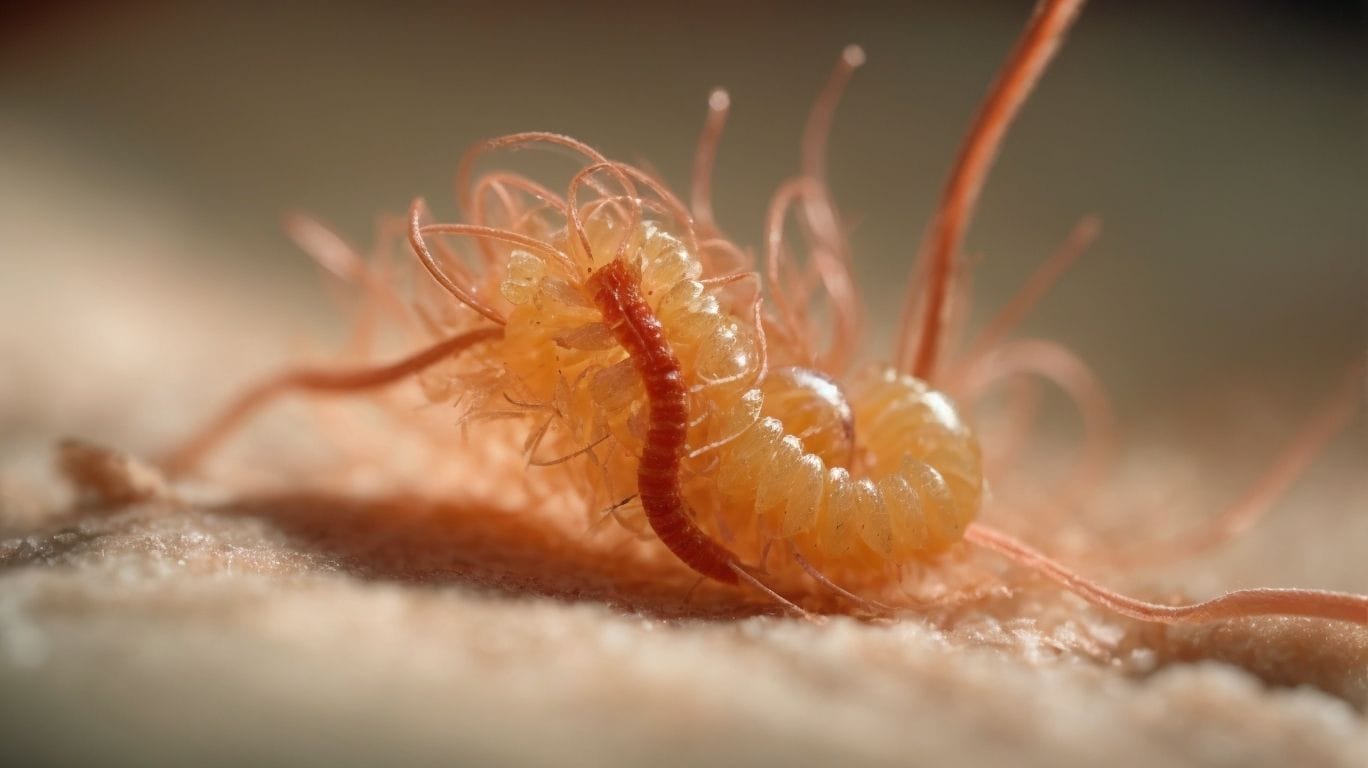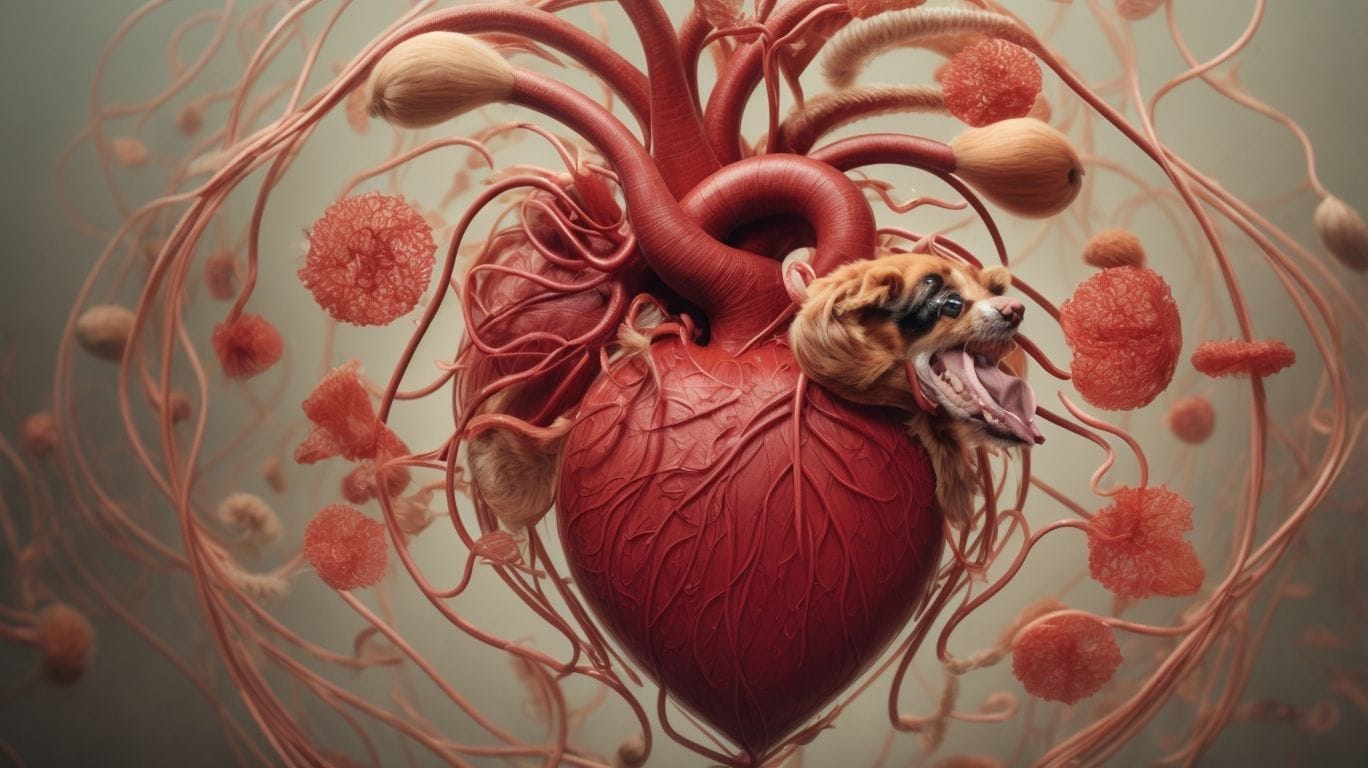Heartworm disease is a serious and potentially fatal condition that can affect dogs. Understanding how dogs contract heartworms is crucial in preventing and managing this disease. This article provides an overview of heartworm disease in dogs. It examines the factors that contribute to its transmission, as well as the signs, diagnosis, treatment, and prevention methods associated with this condition.
Heartworm disease, caused by the parasitic worm Dirofilaria immitis, is primarily transmitted through mosquitoes. The life cycle of heartworms involves several stages, during which the larvae develop into adults and inhabit the heart, lungs, and blood vessels of infected dogs.
The role of mosquitoes in heartworm transmission is vital. When an infected mosquito bites a dog, it deposits heartworm larvae into the bloodstream. Over time, these larvae mature into adult worms, causing damage to the heart and lungs. Therefore, dogs that reside in areas where mosquitoes are prevalent are at a higher risk of contracting heartworms.
Apart from mosquito exposure, certain factors can increase a dog’s susceptibility to heartworm infection. These include a lack of regular preventive medication, living in regions with a high incidence of heartworm disease, and traveling to areas where heartworms are common.
When a dog becomes infected with heartworms, the disease progresses through various stages. In the early stages, dogs may not display any symptoms or show only mild signs such as coughing or fatigue. However, as the disease advances, more severe symptoms can occur, including difficulty breathing, weight loss, and heart failure.
Diagnosing heartworm disease is crucial for timely intervention. Various diagnostic tests, including blood tests and imaging techniques, can detect the presence of heartworms in dogs.
Treatment options for heartworm disease in dogs aim to eliminate the adult worms and manage the associated complications. Preventive measures such as administering monthly heartworm medications and avoiding mosquito bites can help protect dogs from heartworm infections.
By understanding how dogs contract heartworms and taking appropriate preventive measures, dog owners can safeguard their pets’ health and well-being. Regular veterinary check-ups, adherence to preventive medication, and mosquito control efforts can significantly reduce the risk of heartworm disease in dogs.
Key takeaway:
- Dogs get heartworm through mosquito bites: Mosquitoes play a crucial role in transmitting heartworm larvae to dogs when they bite. The larvae then develop into adult worms in the dog’s body.
- Factors that increase heartworm risk: Certain factors, such as geographic location, exposure to infected mosquitoes, and not using preventive measures, can increase a dog’s risk of getting heartworm.
- Prevention is key: Protecting dogs from heartworm infection is crucial. Regular use of preventive medications, reducing mosquito exposure, and regular screening and testing can help prevent heartworm disease in dogs.
Overview of Heartworm in Dogs

Photo Credits: Petnarnia.Com by Nicholas Thomas
Heartworm is a serious and potentially fatal disease that affects dogs. It is caused by a parasite called Dirofilaria immitis, which is transmitted through the bite of infected mosquitoes. Once inside the dog’s body, the heartworm larvae migrate to the heart and lungs, where they mature into adult worms. This can lead to severe damage to the dog’s organs and even death if left untreated. Prevention is key when it comes to heartworm, and there are several options available, including monthly medications and annual injections. Regular testing and check-ups with a veterinarian are essential to ensure early detection and effective treatment of heartworm in dogs.
True story:
I had a Labrador retriever named Max who loved to explore the great outdoors. One summer, we went on a camping trip near a mosquito-infested area. Little did we know an infected mosquito had bitten Max, and soon after, he started showing symptoms of heartworm disease. It was a difficult time, but with the help of our veterinarian, Max underwent treatment and recovered fully. It was a wake-up call for us to prioritize heartworm prevention and protect our furry friend from this devastating disease. Now, Max is healthy, happy, and heartworm-free, enjoying many more adventures with us.
Heartworm is a serious and potentially fatal disease affecting dogs. It is caused by the transmission of a parasite called Dirofilaria immitis through the bite of infected mosquitoes. Once within the dog’s body, heartworm larvae migrate to the heart and lungs, undergoing maturation and causing severe damage to the dog’s organs if left untreated. Prevention is crucial, and various options are available, including monthly medications and annual injections. Regular check-ups and testing with a veterinarian are essential for early detection and effective treatment of heartworm in dogs.
True story:
I have a Labrador retriever named Max who adores exploring the great outdoors. During one summer, we embarked on a camping trip near an area infested with mosquitoes. Unbeknownst to us, Max had been bitten by an infected mosquito, and shortly after, he started exhibiting symptoms of heartworm disease. It was undoubtedly a challenging period, but with the assistance of our veterinarian, Max received treatment and made a complete recovery. This incident served as a wake-up call, prompting us to prioritize heartworm prevention and safeguard our beloved companion from this devastating ailment. Presently, Max is thriving, content, and heartworm-free, relishing countless more adventures alongside us.
What is Heartworm Disease?

Photo Credits: Petnarnia.Com by Jacob Young
Curious about heartworm disease in dogs? Let’s dive into the intriguing world of heartworms and uncover their life cycle. From their sinister ways of infiltrating a dog’s body to the complex stages they go through, we’ll unravel the mysteries surrounding heartworms. Brace yourself for a mind-blowing journey through the fascinating realm of heartworm disease.
Understanding the Heartworm Life Cycle
Understanding the heartworm life cycle is crucial in preventing and treating heartworm disease in dogs. Here are the key steps in understanding the heartworm life cycle:
Microfilariae are transmitted to a mosquito when it bites an infected dog.
The microfilariae develop and molt into the infective stage within the mosquito.
The mosquito bites another dog, transferring the infective larvae.
The larvae enter the dog’s bloodstream and migrate to the heart and lungs.
The larvae grow into adult heartworms, residing in the heart and pulmonary arteries.
The adult female heartworms produce microfilariae, completing the understanding of the heartworm life cycle.
Understanding this life cycle helps dog owners and veterinarians take the necessary steps to prevent heartworm infection and administer appropriate treatment if needed.
How Do Dogs Get Infected with Heartworms?

Photo Credits: Petnarnia.Com by Michael Scott
When it comes to heartworm infection in dogs, understanding how they become infected is crucial. In this section, we’ll uncover the factors contributing to heartworm transmission, with a special focus on the role of mosquitoes. We’ll delve into the various risk factors that increase a dog’s susceptibility to heartworm infection. Get ready to uncover the intricate web of heartworm transmission and discover what puts our furry friends at risk.
The Role of Mosquitoes in Heartworm Transmission
Mosquitoes play a crucial role in the transmission of heartworm disease in dogs, highlighting the importance of protecting dogs from mosquito bites to prevent heartworm transmission. When a mosquito bites an infected dog, it ingests microscopic baby worms called microfilariae, which then mature into infective larvae within the mosquito over 10 to 14 days. These larvae are injected into the dog’s bloodstream when the infected mosquito bites a healthy dog. Over several months, these larvae develop into adult heartworms that reside in the dog’s heart, lungs, and blood vessels.
Factors that Increase the Risk of Heartworm Infection
Certain factors that increase the risk of heartworm infection in dogs include location, climate, and mosquito population. Dogs living in areas with a high number of mosquitoes are more likely to get bitten and infected. Warmer climates provide favorable conditions for heartworm larvae to develop. Additionally, dogs that spend a lot of time outdoors without protection are also at a higher risk. To minimize this risk, it is important to use preventive measures such as regular heartworm medication and mosquito control. Moreover, keeping dogs indoors during peak mosquito activity times can also help reduce the risk of heartworm infection.
What Happens When a Dog is Infected with Heartworms?

Photo Credits: Petnarnia.Com by William Lopez
Discover the chilling reality of a dog’s battle with heartworms. Dive into the intriguing stages and progression of this dreadful disease. Brace yourself for a journey through the intricate dynamics of heartworm infection in dogs as we explore how these parasites stealthily invade their hosts and wreak havoc within their bodies. Prepare to be captivated by the remarkable yet harrowing tale that unfolds, shedding light on the consequences of a dog facing the relentless onslaught of heartworm disease.
Stages and Progression of Heartworm Disease in Dogs
Stages and Progression of Heartworm Disease in Dogs
Heartworm disease in dogs consists of various stages and progresses through each of them, presenting different symptoms and risks. During the initial stages, dogs may not display any noticeable signs of infection. As the disease advances, dogs may experience a persistent cough, fatigue, and difficulty breathing. In later stages, heartworm disease can result in heart failure and damage to vital organs. It is crucial to identify and commence treatment for heartworm disease promptly to prevent complications. Employing regular heartworm prevention medication is of utmost importance in safeguarding dogs against this potentially deadly disease. Seeking guidance from a veterinarian is essential in determining the appropriate treatment and prevention measures for dogs at different stages of heartworm disease.
Signs and Symptoms of Heartworm Disease in Dogs

Photo Credits: Petnarnia.Com by Joshua Smith
Spotting signs and symptoms of heartworm disease in dogs is crucial for early detection and treatment. From subtle changes to more severe indications, understanding what to look for can mean the difference between life and death for our furry friends. In this section, we’ll explore the diverse range of symptoms that may appear during different stages of the disease. From the early-stage symptoms to the advanced-stage manifestations, we’ll unveil the red flags that every dog owner should be aware of. So, let’s dive in and learn how to protect our beloved canine companions from the dangers of heartworm disease.
Early-Stage Symptoms of Heartworm Disease
Early-stage symptoms of heartworm disease in dogs are often subtle and can easily be overlooked. Common early signs include coughing, fatigue, and decreased appetite. Some dogs may experience mild weight loss or have difficulty breathing. It’s important to note that these symptoms can easily be attributed to other health issues, making it crucial to get your dog tested for heartworm if any of these signs are present. Remember, early detection and treatment are key to a successful recovery. If you suspect your dog may have early-stage symptoms of heartworm disease, consult your veterinarian immediately.
Advanced-Stage Symptoms of Heartworm Disease
Severe damage to the heart and lungs in dogs, which is indicated by advanced-stage symptoms of heartworm disease, may include:
- Coughing, particularly during or after exercise
- Breathing difficulties or shortness of breath
- Weakness or lethargy
- Loss of weight or loss of appetite
- Abdominal swelling caused by fluid accumulation
- Fainting or suddenly collapsing
If your dog displays any of these symptoms, it is essential to seek veterinary attention promptly. Depending on the severity of the condition, treatment options for advanced-stage heartworm disease may involve medication, surgery, or a combination.
Prevention is always preferable to treatment. Safeguard your dog against heartworm disease by administering monthly preventive medication and minimizing exposure to mosquitoes.
Methods of Diagnosing Heartworm Disease in Dogs

Photo Credits: Petnarnia.Com by Jacob Torres
When it comes to diagnosing heartworm disease in dogs, veterinarians use various methods. In this section, we’ll explore the different diagnostic tests available for detecting heartworm infection in dogs. From blood tests to imaging techniques, we’ll uncover the tools used by experts to diagnose this serious condition accurately. So, let’s dive into the world of heartworm diagnostics and learn how these tests help identify and treat this preventable disease.
Diagnostic Tests for Heartworm Infection
To diagnose heartworm infection in dogs, veterinarians utilize a variety of diagnostic tests, which are essential for confirming the presence of heartworms and determining the stage of the disease. Here are the primary diagnostic tests for heartworm infection:
Blood tests: These diagnostic tests detect the presence of heartworm antigens, which are proteins produced by adult female heartworms.
X-rays or radiographs: X-rays are valuable in revealing signs of heartworm disease in the lungs and heart.
Ultrasound: Ultrasonography is used to visualize the heart and blood vessels, allowing the detection of adult heartworms.
Microfilarial tests: This specific diagnostic test checks for the presence of microfilariae, which are the larvae of heartworms circulating in the bloodstream.
Pro-tip: Regular heartworm testing is crucial, especially in endemic areas, to ensure early detection and timely treatment of heartworm disease in dogs.
Treatment and Prevention of Heartworm Disease in Dogs

Photo Credits: Petnarnia.Com by Patrick King
When it comes to treating and preventing heartworm disease in our beloved dogs, there are important considerations to keep in mind. In this section, we’ll explore the various treatment options available for dogs already infected with heartworms, as well as the preventive measures we can take to protect our furry friends from this debilitating disease. From discussing the different treatment approaches to unveiling effective preventive measures, we’ll ensure our dogs stay happy, healthy, and heartworm-free!
Heartworm Treatment Options for Infected Dogs
When it comes to heartworm treatment options for infected dogs, there are several available choices. Here are some approaches to treat heartworm disease in dogs:
- Immiticide injections: This is the most common and effective treatment option for heartworm disease. It involves a series of injections that aim to kill the adult heartworms.
- Surgical removal: In severe cases, when the heartworm burden is high, surgical removal of the adult worms may be necessary as a treatment option.
- Antibiotics: Antibiotics are often used in combination with other treatment methods to prevent secondary infections in dogs with heartworm disease.
- Pain management: Medications may be prescribed to manage pain and discomfort experienced by dogs during the treatment process for heartworm disease.
- Rest and restricted activity: Dogs undergoing heartworm treatment need to rest and have restricted activity to minimize complications and promote recovery.
- Follow-up care: After the treatment, regular check-ups and heartworm prevention measures become essential to prevent re-infection in dogs.
Preventive Measures to Protect Dogs from Heartworm Infection
To protect dogs from heartworm infection, it is essential to implement preventive measures. Here are some steps to adhere to:
Consult with a veterinarian: Seek professional advice regarding preventive measures against heartworm infection.
Administer preventive medication: Give your dog the prescribed heartworm preventive medication as recommended by the veterinarian.
Follow dosage and schedule: Ensure regular and timely administration of the medication to maximize its effectiveness.
Keep up with vet check-ups: Regular visits to the veterinarian aid in monitoring and preventing heartworm infection.
Maintain a clean environment: Eliminate stagnant water sources where mosquitoes, which transmit heartworm disease, breed.
By diligently following these preventive measures, you can effectively protect your beloved pet from heartworm infection and safeguard their overall well-being.
Some Facts About How Dogs Get Heartworm:
- ✅ Heartworm disease in dogs is caused by parasitic worms called heartworms that are transmitted through infected mosquitoes. (Source: Our Team)
- ✅ The larvae of heartworms develop under the dog’s skin and then migrate to the blood vessels of the heart and lungs, where they grow into adults. (Source: Our Team)
- ✅ Adult heartworms can grow to a length of 5-12 inches in dogs. (Source: Our Team)
- ✅ Heartworm disease can cause severe damage to the lungs’ blood vessels, even before any symptoms appear. (Source: Our Team)
- ✅ The best way to prevent heartworm disease in dogs is by using a monthly heartworm disease preventive. (Source: Our Team)


